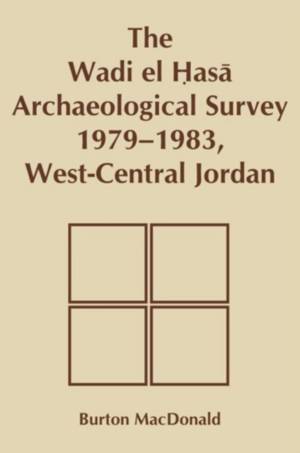
- Afhalen na 1 uur in een winkel met voorraad
- Gratis thuislevering in België vanaf € 30
- Ruim aanbod met 7 miljoen producten
- Afhalen na 1 uur in een winkel met voorraad
- Gratis thuislevering in België vanaf € 30
- Ruim aanbod met 7 miljoen producten
Wadi El Hasa Archaeological Survey 1979-1931, West-Central Jordan
Burton MacDonaldOmschrijving
In this major work Professor MacDonald chronicles an intensive and systematic archaeological survey of the southern flank of the Wadi el Hasa in West-Central Jordan. The survey resulted in the recovery of human evidence spanning the Lower Paleolithic to the Ottoman period (500,000 B.C.-A.D. 1918). The area is cut by a number of impressive and deep, south-to-north flowing wadis. As a region marginal for farming but stable for grazing, it would be the first to "empty out" and the last to "fill up" compared to more favourable regions. The methodology employed included a combination of purposive, predictive, and pedestrian transects. Lithics spanning the Lower Paleolithic to the end of the Early Bronze period (500,000-2000 B.C.) and ceramics covering the period from the Pottery Neolithic to the end of the Ottoman domination (4750 B.C.-A.D. 1918) were collected in the area. Sites surveyed included lithic and sherd scatters, camps, hamlets, villages, roads, milestones, fortresses, watchtowers, and mills.
This research sheds new light on the settlement of the area, which now appears to have been most dense during the Middle Paleolithic, Iron II, Nabataean, and Byzantine periods.
Specificaties
Betrokkenen
- Auteur(s):
- Uitgeverij:
Inhoud
- Aantal bladzijden:
- 422
- Taal:
- Engels
Eigenschappen
- Productcode (EAN):
- 9781554585229
- Verschijningsdatum:
- 15/03/2012
- Uitvoering:
- Paperback
- Formaat:
- Trade paperback (VS)
- Afmetingen:
- 175 mm x 251 mm
- Gewicht:
- 771 g

Alleen bij Standaard Boekhandel
Beoordelingen
We publiceren alleen reviews die voldoen aan de voorwaarden voor reviews. Bekijk onze voorwaarden voor reviews.











